Catalog Ads for affordable, low-cost, and discount brands
October 14, 2024
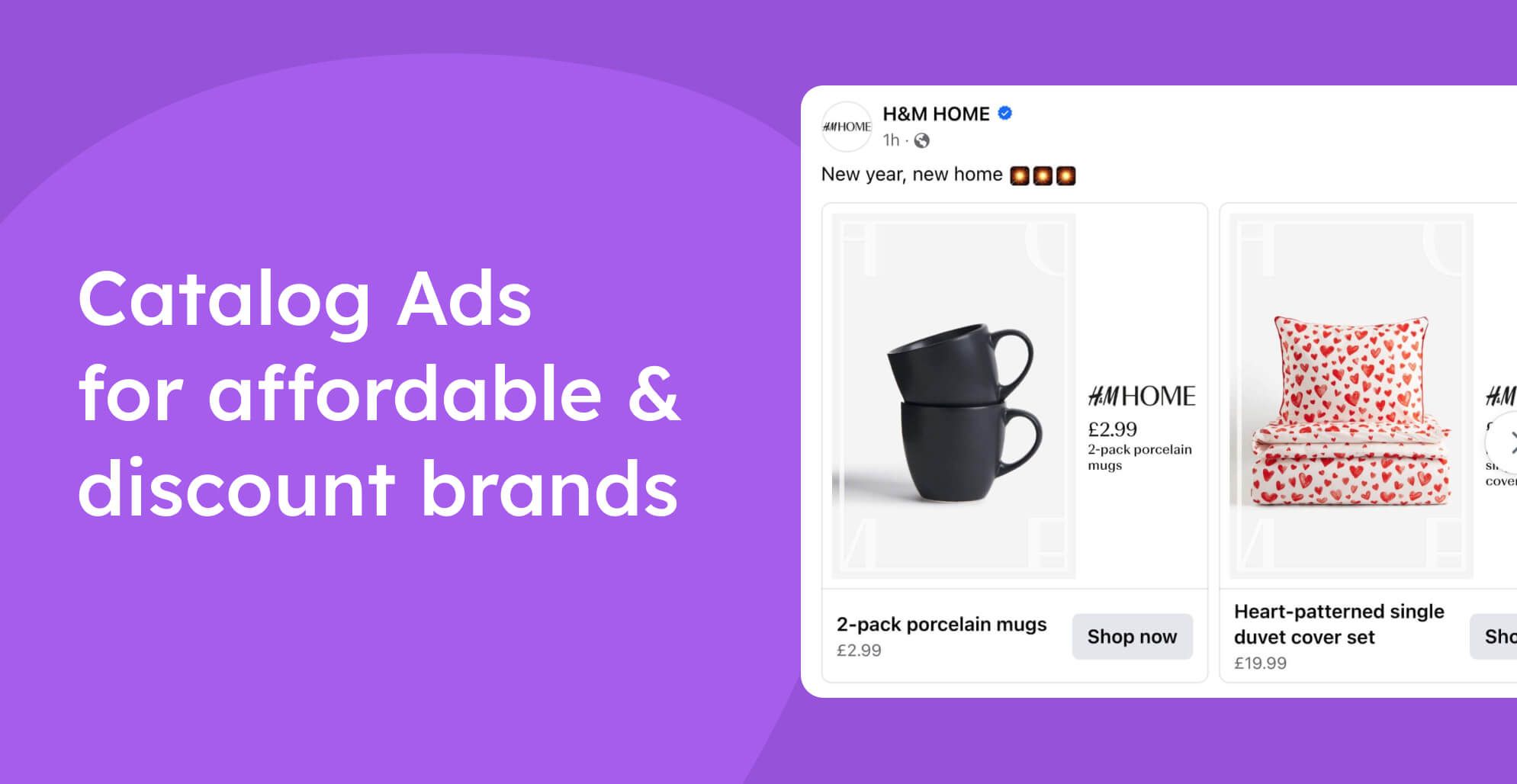
.
If you're running a discount brand or low-cost e-commerce store, your catalog ads require different tactics. Strategies that perform for premium products don’t necessarily transfer to value-priced items.
We’ve studied thousands of Catalog Ads designs, across 6.5 billion impressions, to understand precisely what works for value-focused brands.
This guide breaks down what to include in your catalog ads when price and affordability is your main selling point.
Bookmark this page by pressing ctrl + D / cmd + D, or by clicking the star icon in your URL bar ⭐️.
Here you have the insights in a quick cheat sheet - click to get more details:
The most used product fields in Catalog Ads designs:
The moderately used product fields in Catalog Ads designs:
The rarely used product fields in Catalog Ads designs:
Showing Prices in your Catalog Ads
55% of all discount retailers designing their Catalog Ads with Confect show the price of the product.
The more affordable your products are, the better performance you will typically see showing prices.
- Affordable shops see a +60% improvement in Return on Ad Spend when showing prices
- Mid-end shops see a +43% improvement in Return on Ad Spend when showing prices
- High-end/ Luxury shops see a +35% improvement in Return on Ad Spend when showing prices
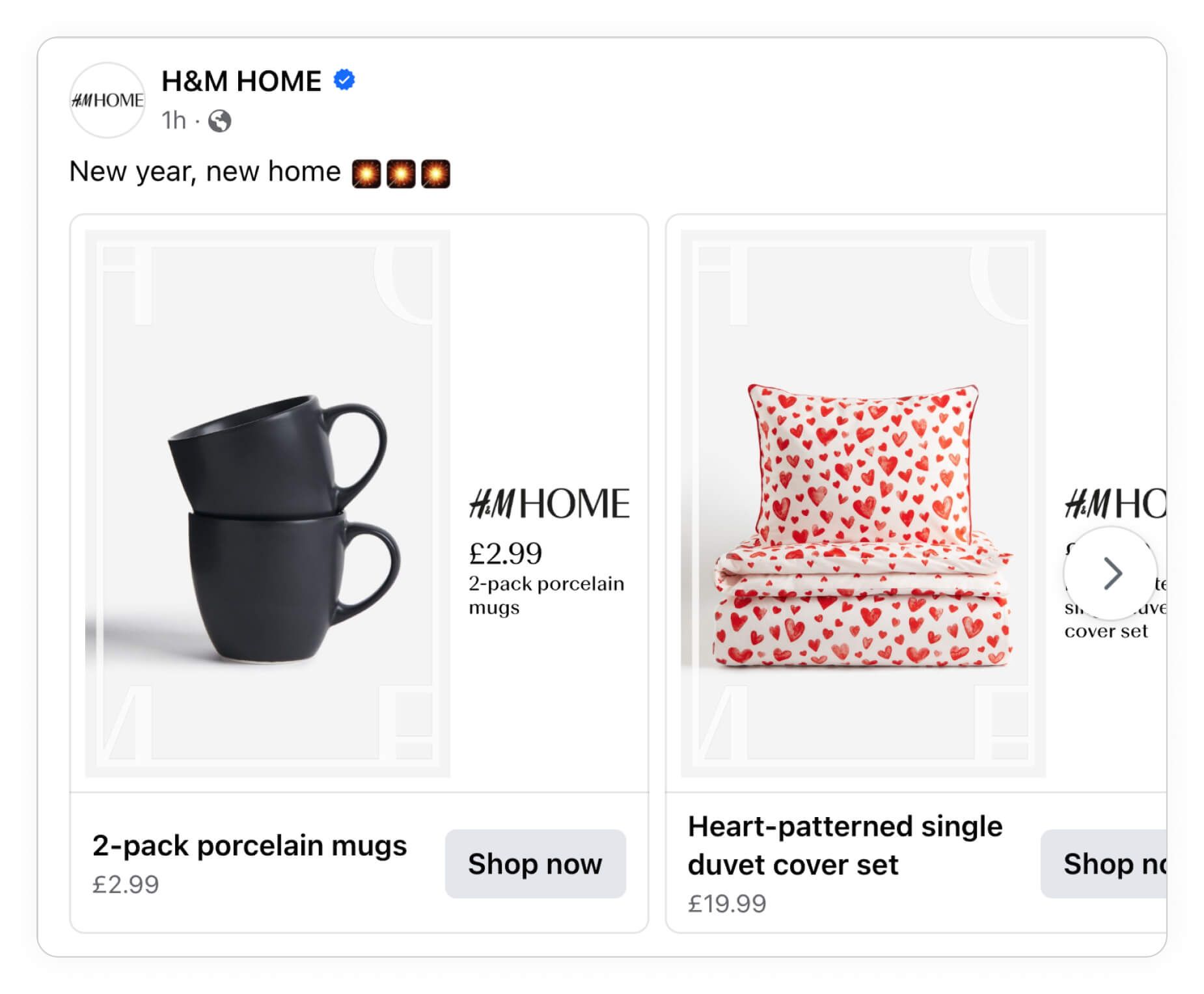
The Catalog Ad from H&M above is a great example of highlighting prices very clearly, making the value proposition immediately visible to cost-conscious shoppers.
Here's how showing prices on average influence Catalog Ads:
Return On Ad Spend
+60%
Cost Per Purchase
+38%
Click Through Rate
-10%
Cost Per Click
+37%
Conversion Rate
+3%
Usage
55%
These numbers show how Catalog Ads showing prices perform on average compared to Catalog Ads not showing prices.
For discount and low-cost brands, price transparency isn't just helpful – it's essential. With a +60% boost in ROAS, displaying your competitive prices right in the ad helps value-focused shoppers quickly compare costs before clicking.
This pre-qualifies your traffic, leading to better Cost Per Purchase efficiency despite a slightly lower Click Through Rate.
Remember that these are average numbers. For some brands, prices perform better, and for other brands, prices perform worse.
Advantages of showing product prices for discount brands:
Clear pricing sets expectations for budget-conscious buyers
Makes it easy to compare value against competitors
Helps attract price-sensitive customers directly
Disadvantages of showing product prices for discount brands:
Could turn away users if prices appear higher than expected
May encourage only price-driven customers, reducing brand loyalty
Might not be effective if your prices aren't notably competitive
You can learn more about showing prices in your Catalog Ads right here.
Showing your Logo in Catalog Ads
44% of all discount retailers designing their Catalog Ads with Confect show their own logo.
While many assume logos are more important for premium brands, our data shows that discount retailers actually see significant ROAS improvements from logo inclusion.
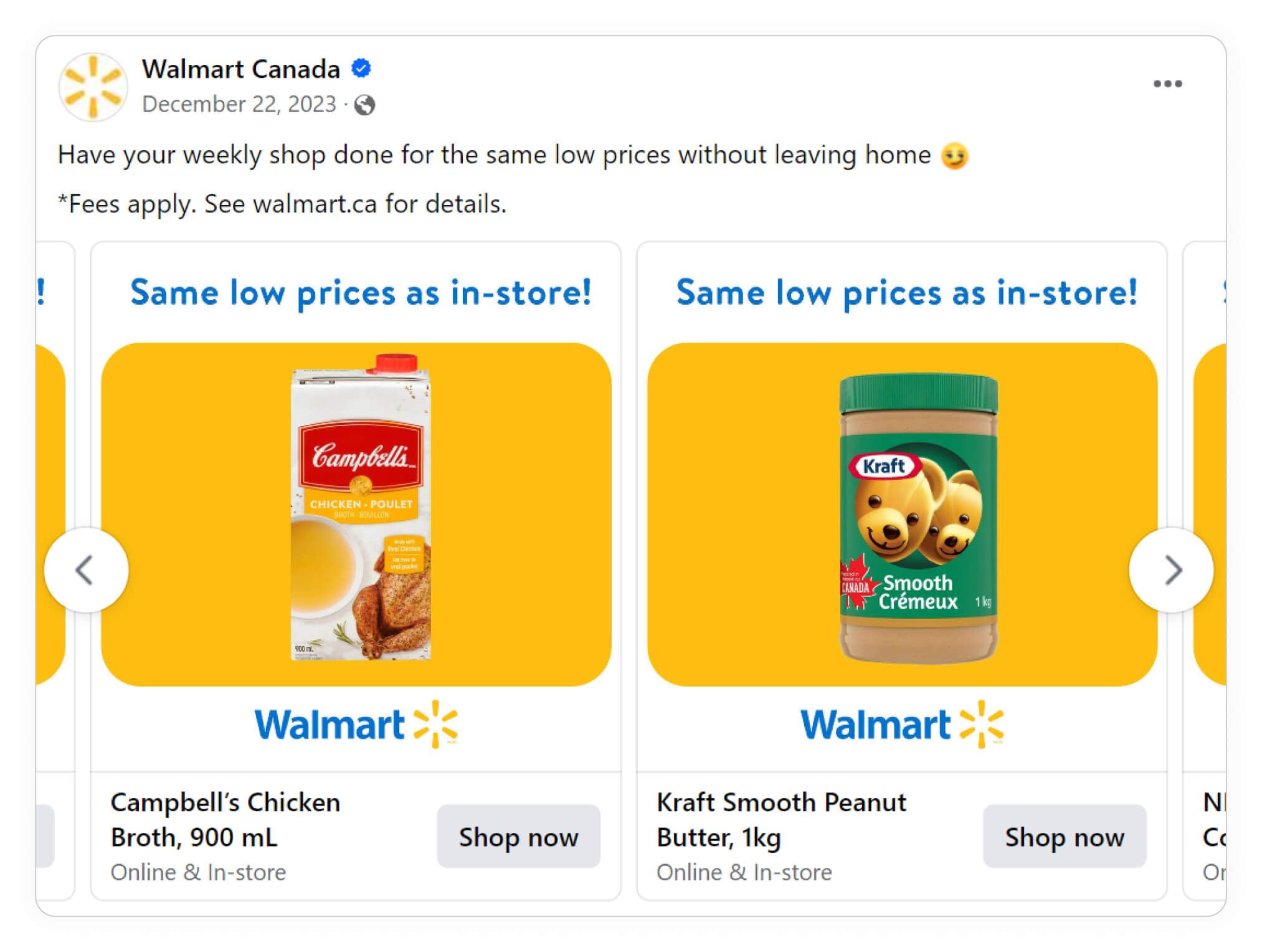
The above Catalog Ad from Walmart is a solid example of utilizing brand recognition while still emphasizing affordable pricing in a competitive discount marketplace.
Here's how showing your logo on average influence Catalog Ads:
Return On Ad Spend
+42%
Cost Per Purchase
+47%
Click Through Rate
-6%
Cost Per Click
+40%
Conversion Rate
-19%
Usage
44%
These numbers show how Catalog Ads showing the logo of the advertiser perform on average compared to Catalog Ads not showing the logo.
Remember that these are average numbers. For some brands, their logo perform better, and for other brands, their logo perform worse.
For discount brands, logo visibility creates legitimacy in a marketplace where customers may be skeptical about quality. With a +42% boost in ROAS, your logo serves as a trust signal that counters the "too good to be true" reaction that sometimes accompanies very low prices.
Remember that these are average numbers. For some brands, their logo perform better, and for other brands, their logo perform worse.
Advantages of showing your logo:
Builds brand recognition among bargain hunters
Highlights the legitimacy of your discount store
Ideal for retargeting price-conscious shoppers
Disadvantages of showing your logo:
Can distract from the product itself or your price point
May lower performance if your discount brand isn't well-known
Might be repeated multiple times in the same ad
If you’re interested, we have more information and examples on showing your logo in Catalog Ads, plus tips on how to do it with Confect right here.
Showing On-sale designs in your Catalog Ads
45% of all discount retailers designing their Catalog Ads with Confect show some kind of on-sale designs.
The lower prices you have, the better on-sale designs will typically perform.
- Affordable shops see a +97% improvement in Return on Ad Spend when showing on-sale designs
- Mid-end shops see a +48% improvement in Return on Ad Spend when showing on-sale designs
- High-end/ Luxury shops see a +25% improvement in Return on Ad Spend when showing on-sale designs
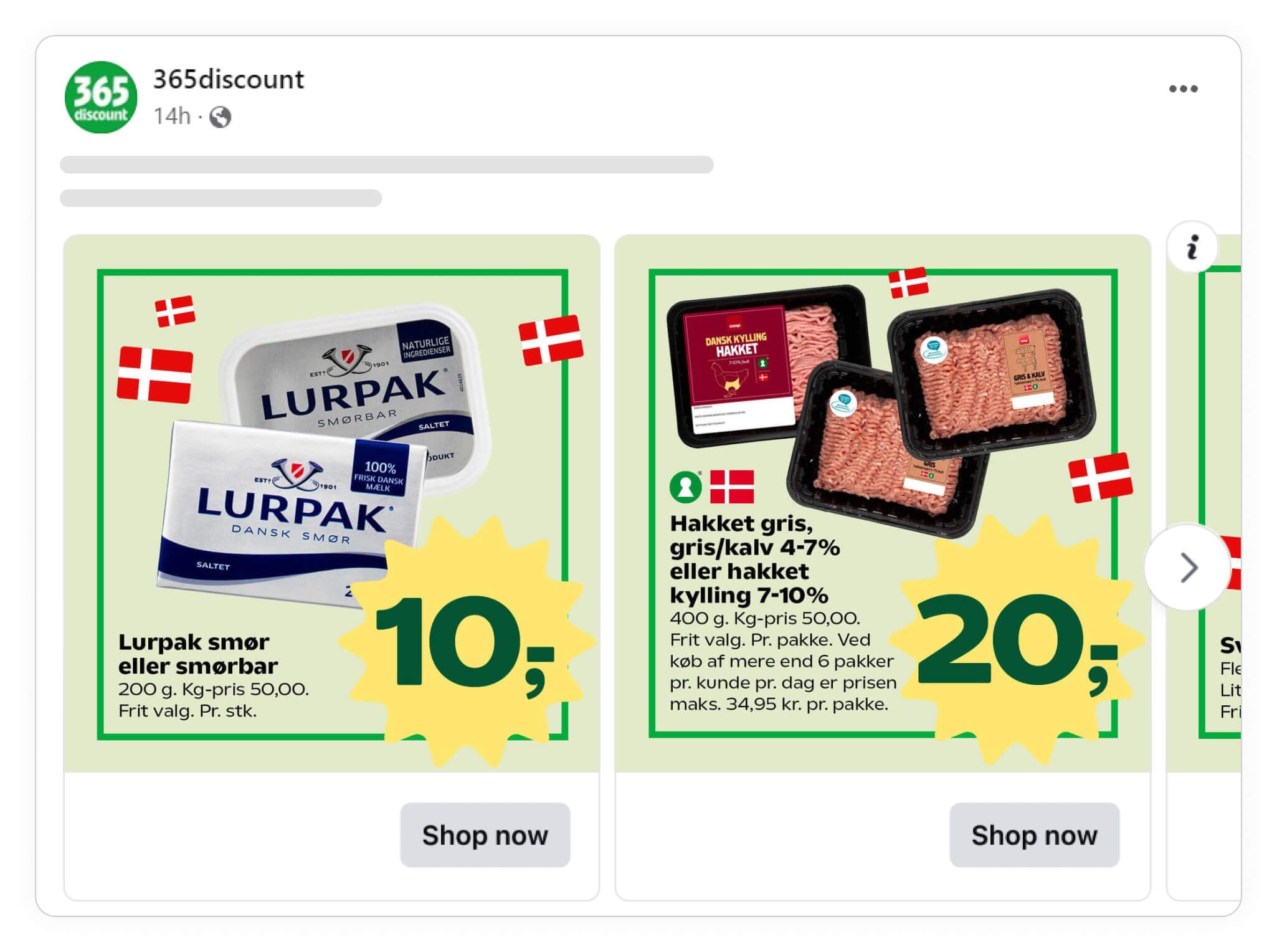
The Catalog Ad from 365Discount above shows how sale designs create a sense of urgency and value opportunity for already affordable products.
Here's how showing on-sale designs on average influence Catalog Ads:
Return On Ad Spend
+97%
Cost Per Purchase
+21%
Click Through Rate
-1%
Cost Per Click
+23%
Conversion Rate
+8%
Usage
45%
These numbers show how Catalog Ads showing on-sale designs perform on average compared to Catalog Ads not showing on-sale designs.
Remember that these are average numbers. For some brands, on-sale designs perform better, and for other brands, on-sale designs perform worse.
For discount retailers, highlighting "on-sale" status creates a powerful double incentive – not just low prices, but even lower than usual. The remarkable +97% ROAS improvement shows how powerfully sale messaging resonates with value-focused shoppers compared to premium brands.
Advantages of showing sale designs:
Drives conversions with urgency for price-sensitive shoppers
Increases sales volume for discount retailers
Ideal for clearing out lower-priced inventory quickly
Disadvantages of showing sale designs:
May reduce the perceived value of your already affordable products
Can drive customers to only look for sales rather than buying at regular prices
Decreases already thin profit margins on discount items
You can learn more about showing on-sale designs during campaigns in your Catalog Ads right here, and view a lot of sales and campaign Catalog Ad examples here.
Showing Product Names in your Catalog Ads
44% of all discount retailers designing their Catalog Ads with Confect show the name of the product.
Only show product names in your catalog and design if they add value - like branded or distinctive names. If the name is generic, it’s better to leave it out to keep the focus on visuals, price, or offers.

The Catalog Ad above from Burger King clearly displays the product alongside other key information, helping shoppers understand what they’re purchasing.
Here's how showing product names on average influence Catalog Ads:
Return On Ad Spend
+24%
Cost Per Purchase
-30%
Click Through Rate
-9%
Cost Per Click
-23%
Conversion Rate
+1%
Usage
44%
These numbers show how Catalog Ads showing product names perform on average compared to Catalog Ads not showing product names.
For discount brands, clear product naming helps customers quickly understand what they're getting at the lower price point. With a +24% ROAS improvement and significantly better Cost Per Purchase, product names help set clear expectations about exactly what affordable item is being offered.
Remember that these are average numbers. For some brands, product names perform better, and for other brands, product names perform worse.
Advantages of showing product names:
Helps budget shoppers recognize the product's purpose instantly
Builds value perception when including feature-rich descriptions
Adds clarity to ads with multiple low-cost alternatives
Disadvantages of showing product names:
Not impactful if your discount products are generic commodities
Limited differentiation for similar low-cost items
May distract from your key selling point of price
Showing Original prices in your Catalog Ads
32% of all discount retailers designing their Catalog Ads with Confect show the original price of the product.
For value-focused brands, showcasing the original higher price creates immediate perception of savings and deal quality.
It instantly signals value and aligns perfectly with what this audience cares about most: getting a great deal.
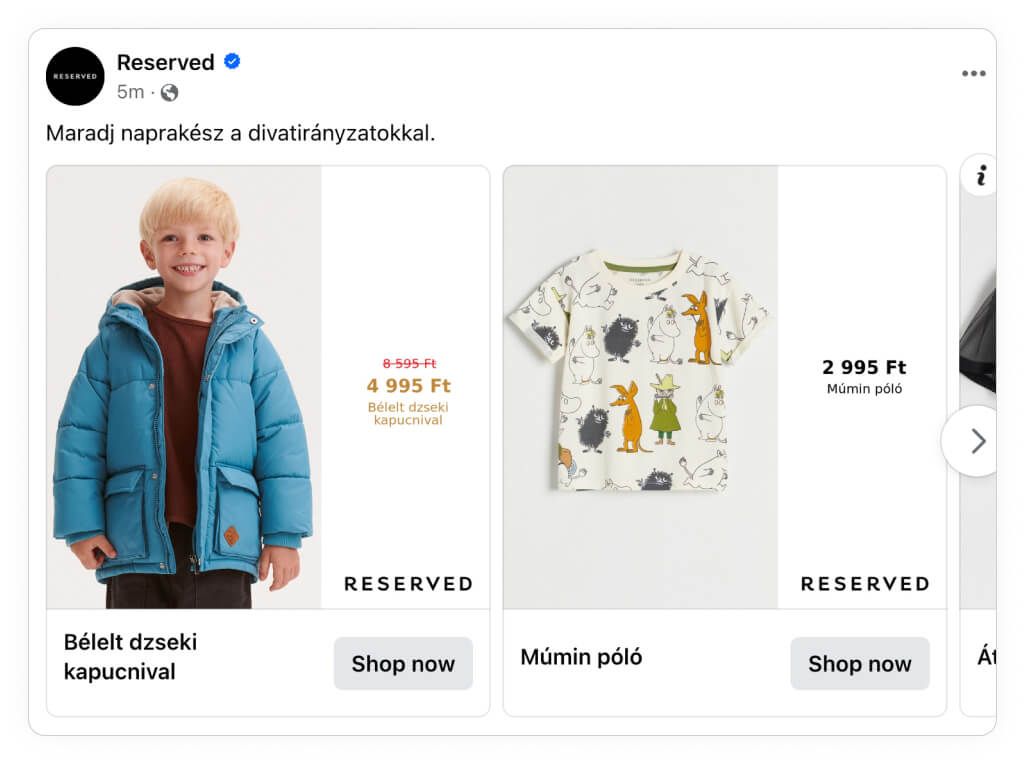
The Catalog Ad above from Reserved positions the original price next to the current sale price, to create a compelling value proposition for bargain seekers.
Here's how showing original prices on average influence Catalog Ads:
Return On Ad Spend
+114%
Cost Per Purchase
+37%
Click Through Rate
-13%
Cost Per Click
+36%
Conversion Rate
+7%
Usage
32%
These numbers show how Catalog Ads showing original prices perform on average compared to Catalog Ads not showing original prices.
For discount retailers, showing original prices delivers one of the biggest ROAS improvements of any design element at a staggering +114%.
Value-focused shoppers are highly motivated by visible evidence of savings, and showing the original price creates immediate context for how good your deal really is.
Remember that these are average numbers. For some brands, original prices perform better, and for other brands, original prices perform worse.
Advantages of showing original prices:
Anchors the sale price to seem exceptionally low
Creates an immediate discount proposition for budget shoppers
Makes the product seem like a smart purchase decision
Helps justify quality despite the low price point
Disadvantages of showing original prices:
Constant discount displays can damage long-term brand perception
May trigger skepticism if the original price seems artificially inflated
Focuses customer attention entirely on price rather than product benefits
Showing additional images in your Catalog Ads
23% of all discount retailers designing their Catalog Ads with Confect show additional images of the product.
For value-focused brands, showing multiple angles or use cases helps overcome quality concerns that may arise from the lower price point.
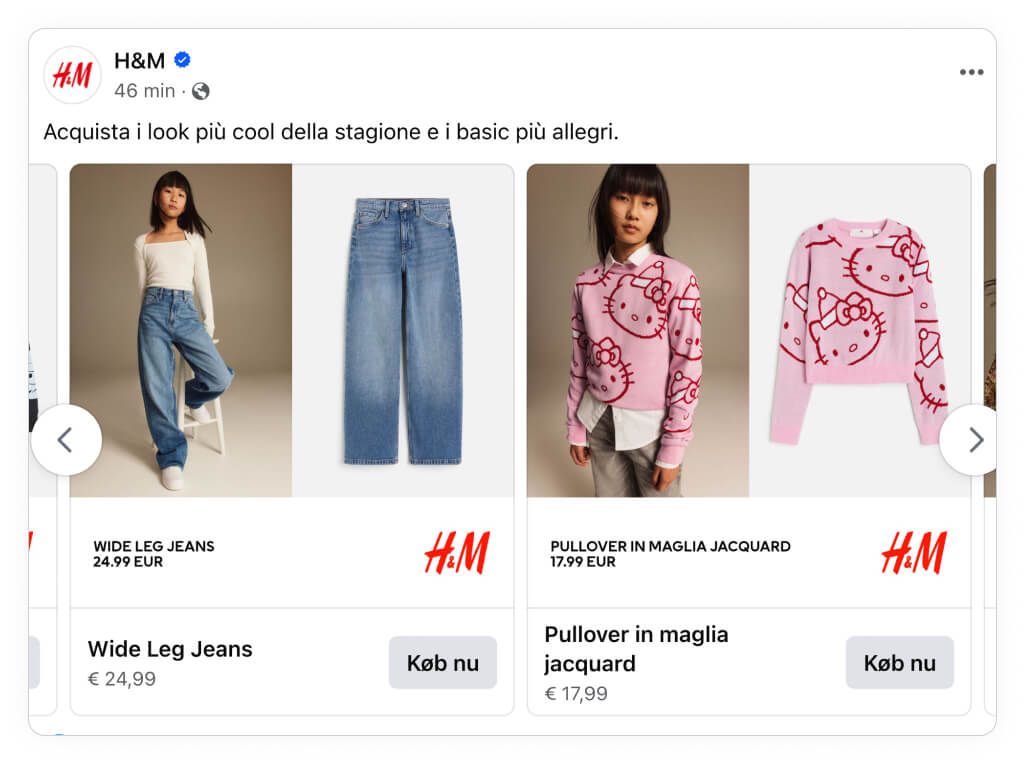
The Catalog Ad above from H&M displays both a product image and a lifestyle image, helping budget shoppers visualize how the affordable item looks in use.
Here's how showing additional images on average influence Catalog Ads:
Return On Ad Spend
+50%
Cost Per Purchase
+22%
Click Through Rate
+11%
Cost Per Click
+21%
Conversion Rate
-24%
Usage
23%
These numbers show how Catalog Ads showing additional images perform on average compared to Catalog Ads not showing additional images.
For discount brands, additional images provide reassurance about product quality despite the lower price. With a +50% ROAS improvement and +11% better Click Through Rate, multiple images help budget shoppers feel more confident about what they're getting for their money.
Remember that these are average numbers. For some brands, additional images perform better, and for other brands, additional images perform worse.
Adding additional images works especially well for fashion and lifestyle products, where showing different angles, styles, or real-life use can drive engagement. But for commodity items, extra images often add little value and can clutter the ad. Keep it simple when the product doesn't need a story.
Advantages of showing additional images:
Shows budget products in multiple contexts to build confidence
Helps value shoppers visualize product usage despite the lower price
Provides reassurance about quality and appearance
Disadvantages of showing additional images:
Can clutter the design and remove focus from the key selling point - price
Might confuse or distract budget-conscious buyers
Can be redundant if the main product image is already clear
Showing Savings and Discounts in your Catalog Ads
28% of all discount retailers designing their Catalog Ads with Confect show the saving of the product.
The more affordable prices you have, the better savings and discounts typically perform in your Catalog Ads.
Affordable shops see a +115% improvement in Return on Ad Spend when showing savings and discounts
Mid-end shops see a +73% improvement in Return on Ad Spend when showing savings and discounts
High-end/ Luxury shops see a +24% improvement in Return on Ad Spend when showing savings and discounts
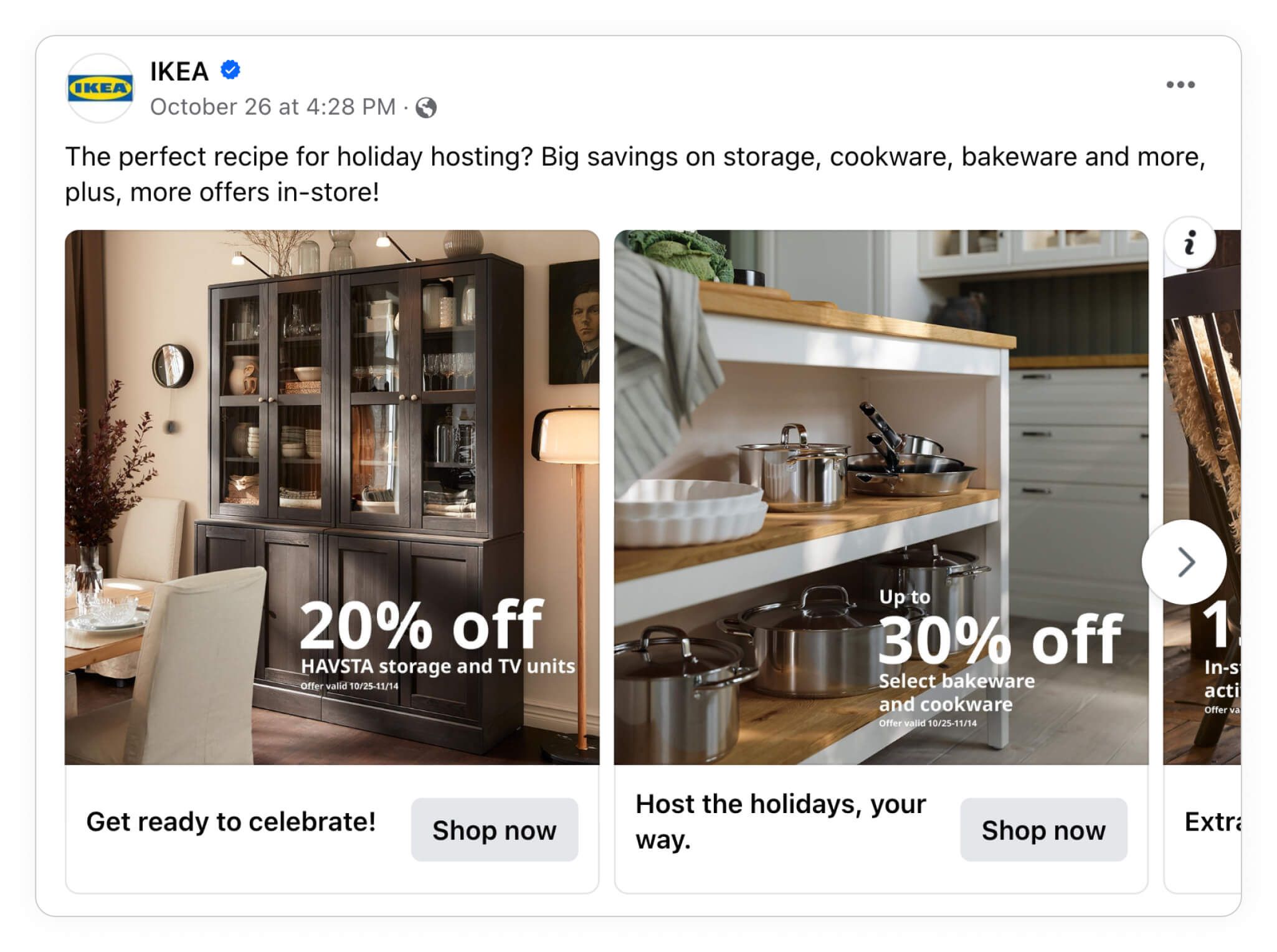
The Catalog Ad above from Ikea highlights savings in a very visible way that immediately communicates the value opportunity.
Here's how showing savings on average influence Catalog Ads:
Return On Ad Spend
+115%
Cost Per Purchase
+28%
Click Through Rate
-5%
Cost Per Click
+23%
Conversion Rate
+4%
Usage
28%
These numbers show how Catalog Ads showing savings perform on average compared to Catalog Ads not showing savings.
For discount retailers, explicitly highlighting savings delivers the highest ROAS improvement of any design element we analyzed at +115%. This powerful effect shows how strongly savings messaging resonates with value-focused shoppers compared to premium-brand customers.
Remember that these are average numbers. For some brands, savings perform better, and for other brands, savings perform worse.
Advantages of showing savings:
Creates immediate sense of value for price-sensitive shoppers
Drives urgency with visible discount amounts
Simplifies decision-making by quantifying the deal's value
Disadvantages of showing savings:
May condition customers to only buy when large discounts are offered
Could devalue your products if savings are constantly emphasized
Might lead to thinner margins on already budget-priced items
You can learn more about showing savings during campaigns in your Catalog Ads right here and see a lot of sales and campaign Catalog Ad examples here.
Showing Dates in your Catalog Ads
11% of all discount retailers designing their Catalog Ads with Confect show dates, days, weeks, or months in the ads.
For value retailers, date displays can create urgency and highlight limited-time opportunities to save even more on already affordable products.
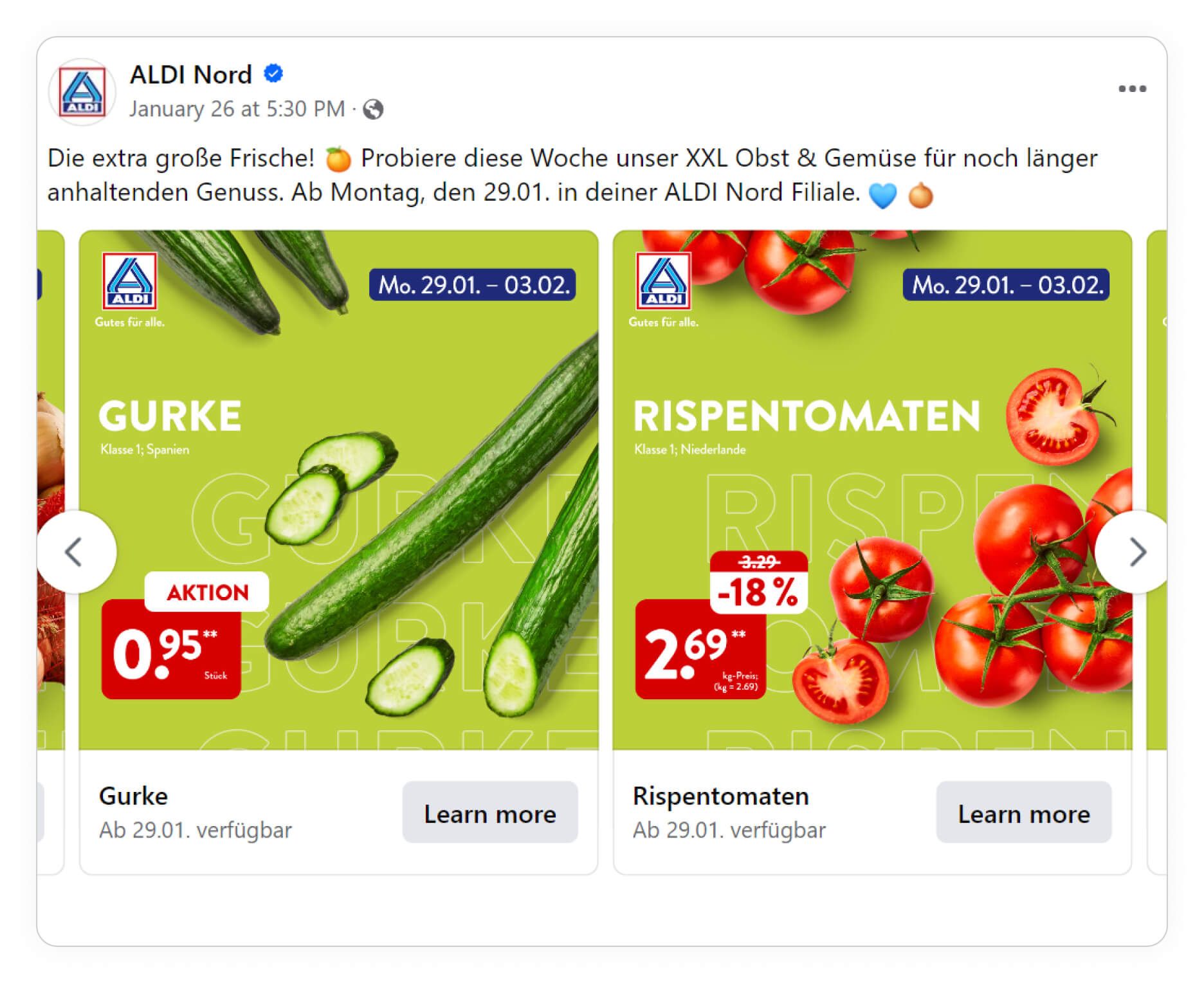
The Catalog Ad above from Aldi showcases their weekly specials with clear date information.
Here's how showing dates on average influence Catalog Ads:
Return On Ad Spend
+22%
Cost Per Purchase
+159%
Click Through Rate
-20%
Cost Per Click
+91%
Conversion Rate
+13%
Usage
11%
These numbers show how Catalog Ads showing dates perform on average compared to Catalog Ads not showing dates.
For discount brands, adding dates to catalog ads drives a moderate +22% ROAS improvement, but has a significant impact on Cost Per Purchase (+159%). Date displays work particularly well for promotional periods and clearance events where discount retailers typically offer their deepest price cuts.
Remember that these are average numbers. For some brands, dates perform better, and for other brands, dates perform worse.
Advantages of showing dates:
Creates urgency with limited-time offers for deal-seeking shoppers
Differentiates seasonal budget deals from everyday low prices
Encourages immediate action from price-sensitive customers
Disadvantages of showing dates:
Adds clutter to the design if not used strategically with your price information
Can distract from other value messaging about the product
Might make discount-focused customers wait for specific sale events
Highlighting News in your Catalog Ads
15% of all discount retailers designing their Catalog Ads with Confect highlight new products in one way or another.
For value-focused brands, "new" messaging can counteract perceptions that discount retailers only offer clearance or outdated merchandise.
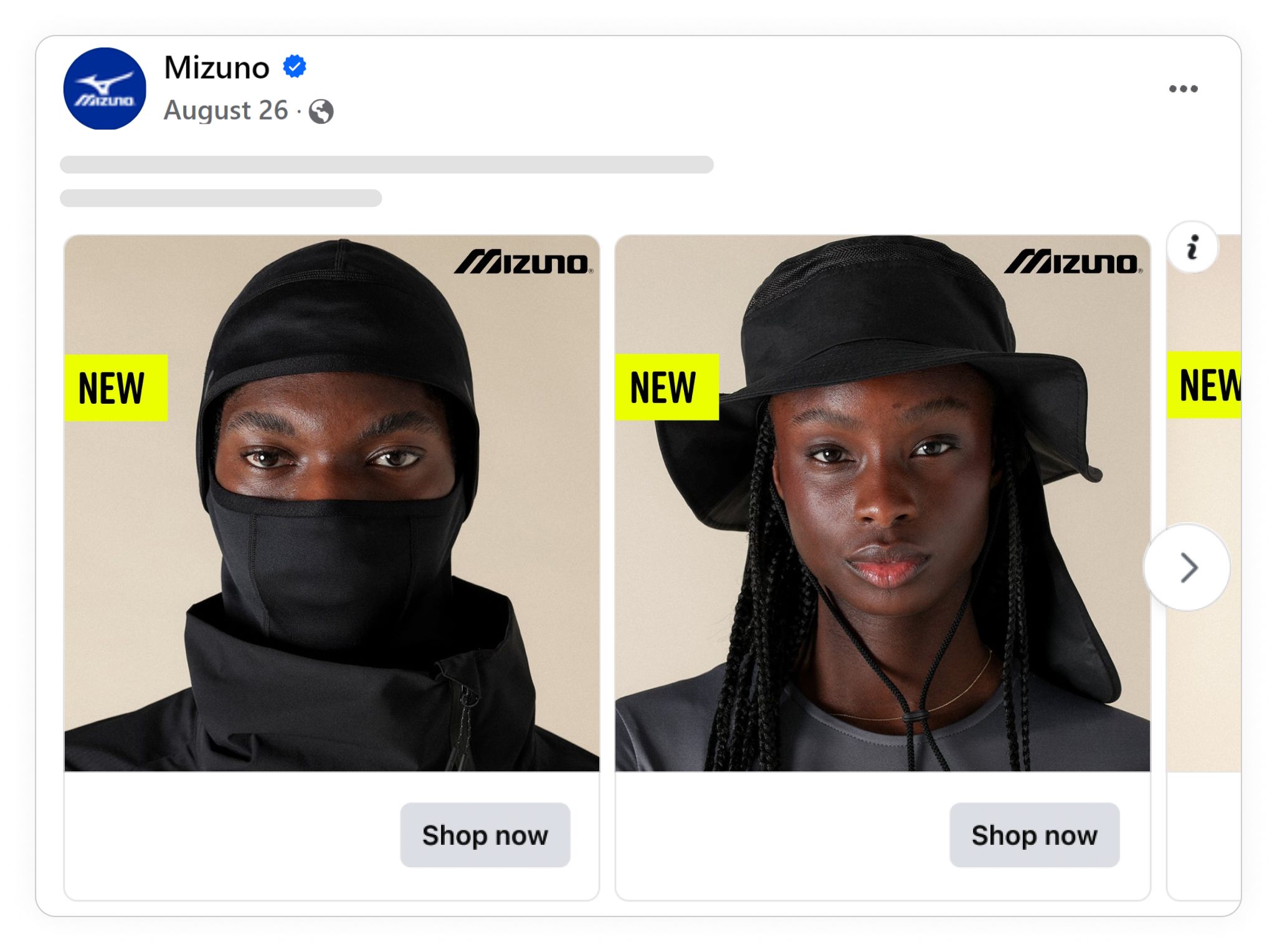
Here's how highlighting news on average influence Catalog Ads:
Return On Ad Spend
+8%
Cost Per Purchase
-3%
Click Through Rate
+29%
Cost Per Click
+6%
Conversion Rate
-19%
Usage
15%
These numbers show how Catalog Ads highlighting news perform on average compared to Catalog Ads not highlighting news.
For discount retailers, "new" messaging provides a modest +8% ROAS improvement but a substantial +29% boost in Click Through Rate. This suggests that while budget shoppers are primarily motivated by price, they still appreciate access to fresh, current products at affordable prices.
Remember that these are average numbers. For some brands, highlighting news perform better, and for other brands, highlighting news perform worse.
Advantages of highlighting new products:
Shows that discount retailers offer current, not just clearance merchandise
Appeals to value shoppers who still want to stay on-trend
Works well in price-sensitive categories with frequent new releases
Disadvantages of highlighting new products:
May be less effective than price-focused messaging for purely budget shoppers
Could create confusion if "new" items aren't actually recent arrivals
Might reduce interest in existing inventory that needs to move
Showing Shipping info in your Catalog Ads
13% of all discount retailers designing their Catalog Ads with Confect show information about their shipping policies.
For value retailers, shipping information can be particularly important as budget-conscious shoppers often consider total cost, including delivery fees.
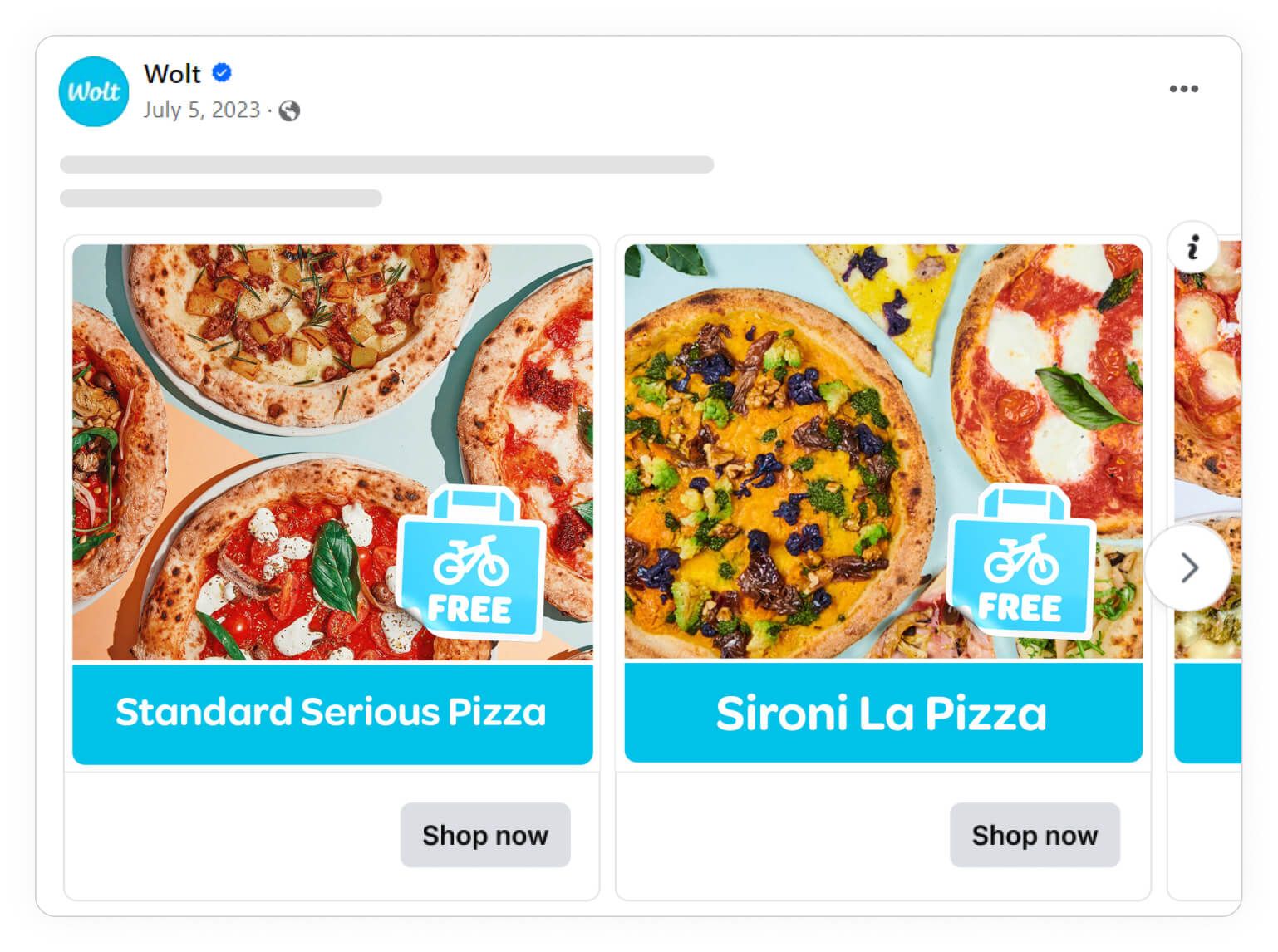
The Catalog Ad above from Wolt demonstrates how emphasizing "Free Shipping" creates additional value perception for their already low-priced products.
Here's how showing shipping info on average influence Catalog Ads:
Return On Ad Spend
-28%
Cost Per Purchase
-42%
Click Through Rate
-29%
Cost Per Click
-11%
Conversion Rate
+45%
Usage
13%
These numbers show how Catalog Ads showing shipping information perform on average compared to Catalog Ads not showing shipping information.
For discount retailers, shipping information actually shows a -28% decrease in ROAS. This suggests that while shipping costs matter to budget shoppers, highlighting them in catalog ads may shift focus away from your core value proposition of product affordability.
However, the significant boost in Conversion Rate (+45%) indicates that when shipping information is included, those who do click are more likely to complete their purchase.
Remember that these are average numbers. For some brands, shipping info perform better, and for other brands, shipping info perform worse.
Advantages of showing shipping info:
Addresses a key concern for price-sensitive shoppers - total cost
Reduces hesitation by clarifying potential hidden costs upfront
Creates additional value perception with free or low-cost shipping offers
Disadvantages of showing shipping info:
Takes focus away from your primary competitive advantage - low product prices
Could highlight a potential weakness if your shipping costs aren't competitive
Might be repeated multiple times across carousel cards, wasting valuable space
Using Product Assets in your Catalog Ads
10% of all discount retailers designing their Catalog Ads with Confect show visual information about the product via Product Assets. They’re especially effective for mid-end shops that don't rely on luxury products or very affordable products.
Affordable shops see a +12% improvement in Return on Ad Spend when showing Product Assets
Mid-end shops see a +75% improvement in Return on Ad Spend when showing Product Assets
High-end/ Luxury shops see a -17% decline in Return on Ad Spend on average when showing Product Assets
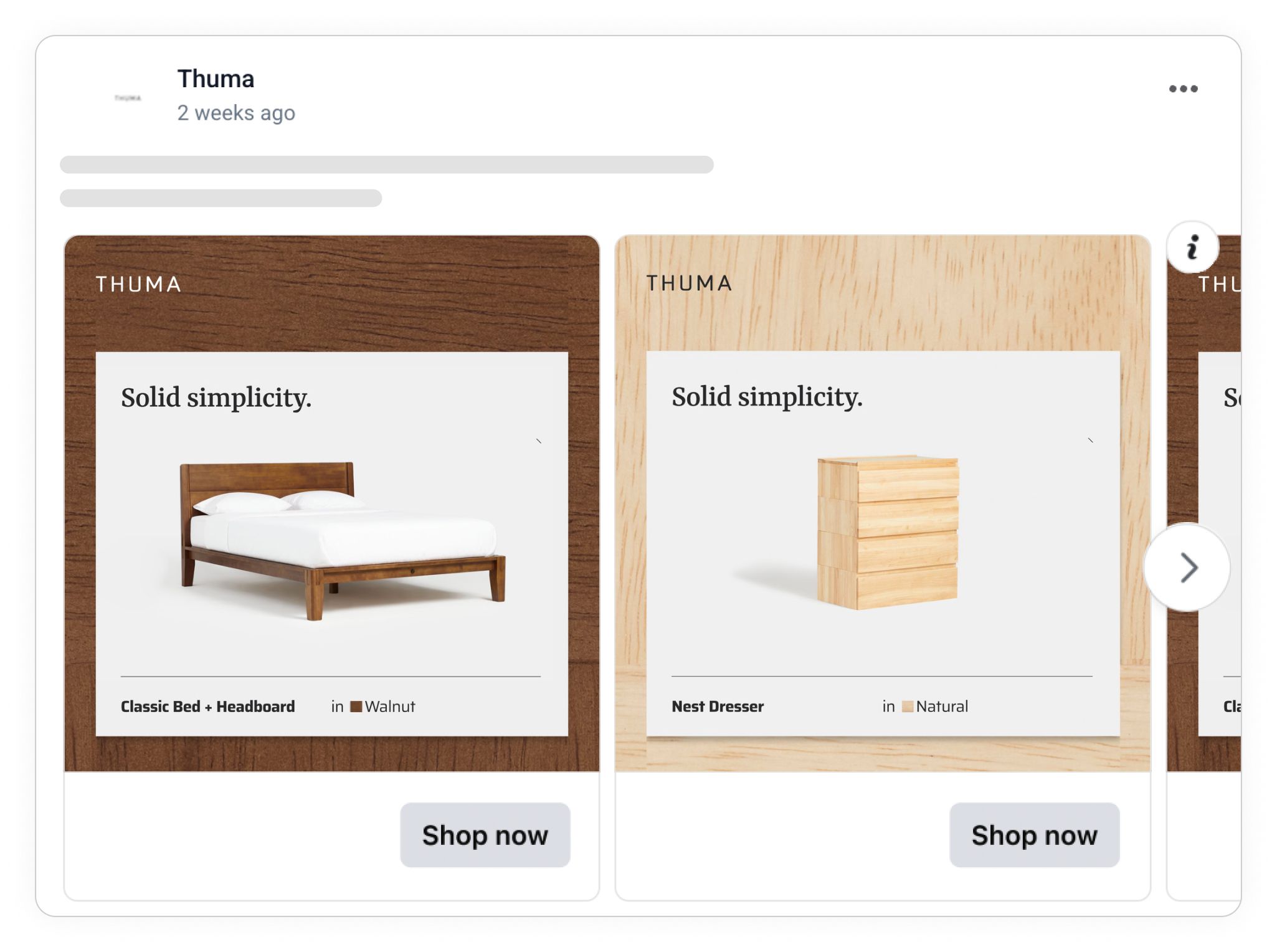
Product Assets can help discount brands highlight key features and benefits that justify the value of their affordably priced items.
Here's how showing product assets on average influence Catalog Ads:
Return On Ad Spend
+12%
Cost Per Purchase
+44%
Click Through Rate
-19%
Cost Per Click
+31%
Conversion Rate
+20%
Usage
10%
These numbers show how Catalog Ads showing product assets perform on average compared to Catalog Ads not showing product assets.
For discount brands, Product Assets deliver a modest +12% ROAS improvement, much lower than the +75% seen by mid-range retailers. This suggests that while feature highlighting is helpful, price-focused shoppers are still primarily motivated by cost considerations rather than product specifications.
Remember that these are average numbers. For some brands, product assets perform better, and for other brands, product assets perform worse.
Product Assets are especially effective for mid-end shops that don't rely on luxury products or very affordable products.
Affordable shops see a +12% improvement in Return on Ad Spend when showing Product Assets
Mid-end shops see a +75% improvement in Return on Ad Spend when showing Product Assets
High-end/ Luxury shops see a -17% decline in Return on Ad Spend on average when showing Product Assets
Advantages of showing product assets:
Highlights key features that justify the value proposition despite low price
Addresses potential quality concerns with budget products
Creates visual shortcuts to important product information
Disadvantages of showing product assets:
May distract from your primary selling point - affordability
Could overwhelm budget shoppers with too much information
Might be less effective than direct price and savings messaging
You can learn more about using Product Assets in your Catalog Ads here.
Showing Social Proof in your Catalog Ads
10% of all discount retailers designing their Catalog Ads with Confect show some kind of social proof.
For value-focused brands, showing ratings and reviews can address quality concerns that sometimes accompany lower price points.
The lower price levels you have compared to competitors, the better showing Social Proof will typically perform.
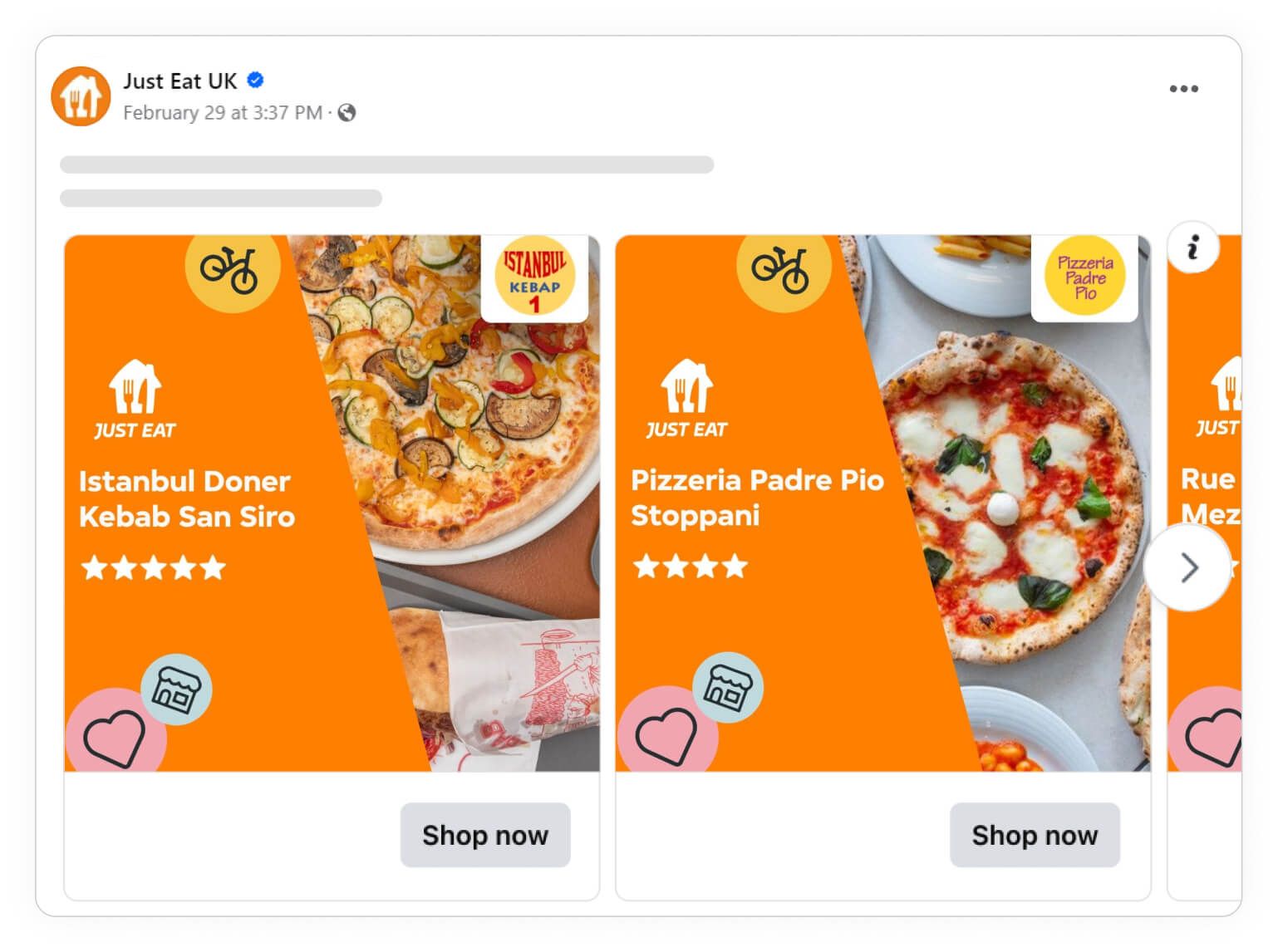
The Catalog Ad above from Just Eat incorporates customer ratings to boost trust.
The lower price levels you have compared to competitors, the better showing Social Proof will typically perform.
Affordable shops see a +72% improvement in Return on Ad Spend when showing Social proof
Mid-end shops see a +32% improvement in Return on Ad Spend when showing Social Proof
High-end/ Luxury shops see a +10% improvement in Return on Ad Spend when showing Social Proof
Here's how showing social proof on average influence Catalog Ads:
Return On Ad Spend
+72%
Cost Per Purchase
+132%
Click Through Rate
-28%
Cost Per Click
+102%
Conversion Rate
+40%
Usage
10%
These numbers show how Catalog Ads showing social proof perform on average compared to Catalog Ads not showing social proof.
For discount retailers, social proof delivers a powerful +72% ROAS improvement. This substantial boost suggests that quality reassurance is particularly valuable for budget brands, where consumers may have concerns about product reliability despite attractive pricing.
Remember that these are average numbers. For some brands, social proof perform better, and for other brands, social proof perform worse.
Advantages of showing social proof:
Builds trust in quality despite low price points
Shows that other bargain hunters were satisfied with their purchase
Mitigates concerns about "too good to be true" offers
Disadvantages of showing social proof:
Takes up space that could be used for price messaging
Might be redundant if ratings aren't exceptionally strong
Could backfire if reviews are mixed or mediocre
You can learn more about showing Social Proof in Catalog Ads here.
Showing Product Brands in your Catalog Ads
5% of all discount retailers designing their Catalog Ads with Confect show the brand of the product.
The more high-end and expensive your products are, the better performance you will typically see when showing the brands of your products.
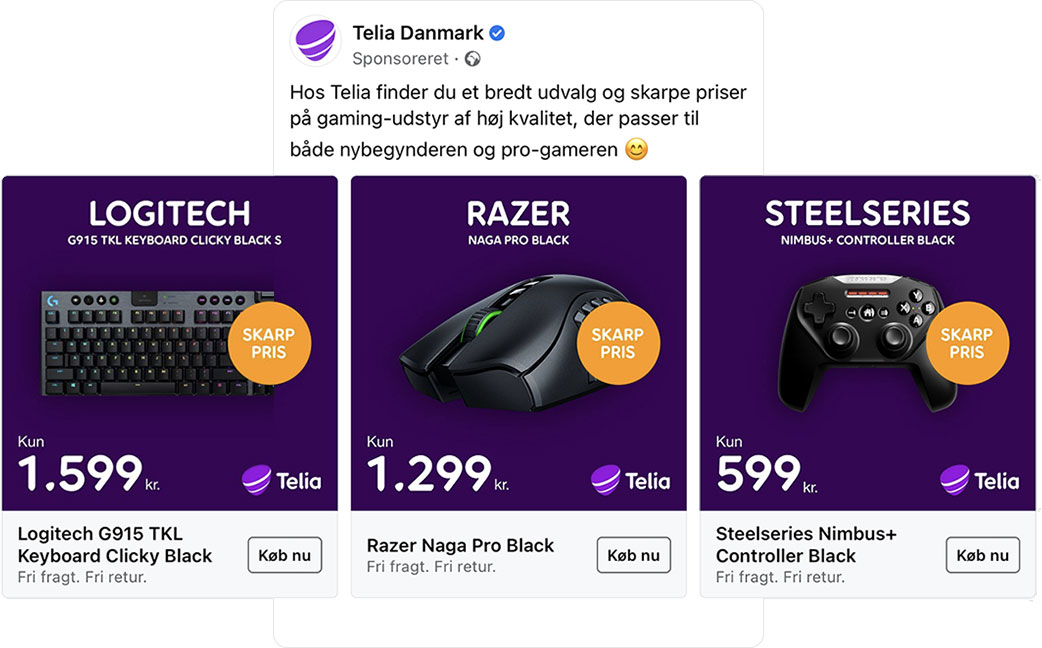
- Affordable shops see a +13% improvement in Return on Ad Spend when showing brands
- Mid-end shops see a +29% improvement in Return on Ad Spend when showing brands
- High-end/ Luxury shops see a +62% improvement in Return on Ad Spend when showing brands
Here's how showing brand names on average influence Catalog Ads:
Return On Ad Spend
+13%
Cost Per Purchase
-53%
Click Through Rate
-13%
Cost Per Click
-8%
Conversion Rate
+54%
Usage
5%
These numbers show how Catalog Ads showing brand names perform on average compared to Catalog Ads not showing brand names.
For discount retailers, brand display has a modest +13% impact on ROAS, significantly lower than the +62% seen by luxury retailers. However, the substantial +54% improvement in Conversion Rate indicates that when budget shoppers do recognize and value a brand offered at a discount, they're much more likely to complete their purchase.
Remember that these are average numbers. For some retailers, brand names perform better, and for other retailers, brand names perform worse.
better, and for other retailers, brand names perform worse.
Advantages of showing product brands:
Creates value perception when offering recognized brands at discount prices
Helps bargain hunters quickly identify familiar products
Boosts credibility for discount retailers selling authentic branded merchandise
Disadvantages of showing product brands:
Less effective for house brands or generic budget products
May set expectations for brand quality that budget products can't always meet
Could diminish impact of price messaging if brand isn't recognized
You can learn more about showing brand names or brand logos in your Catalog Ads here.
Showing Custom_labels in your Catalog Ads
4% of all discount retailers designing their Catalog Ads with Confect show one or more custom_labels with custom information about the product.
For value retailers, custom labels can highlight specific benefits that budget-conscious shoppers prioritize, like "Extra Value Size" or "Budget Pick."
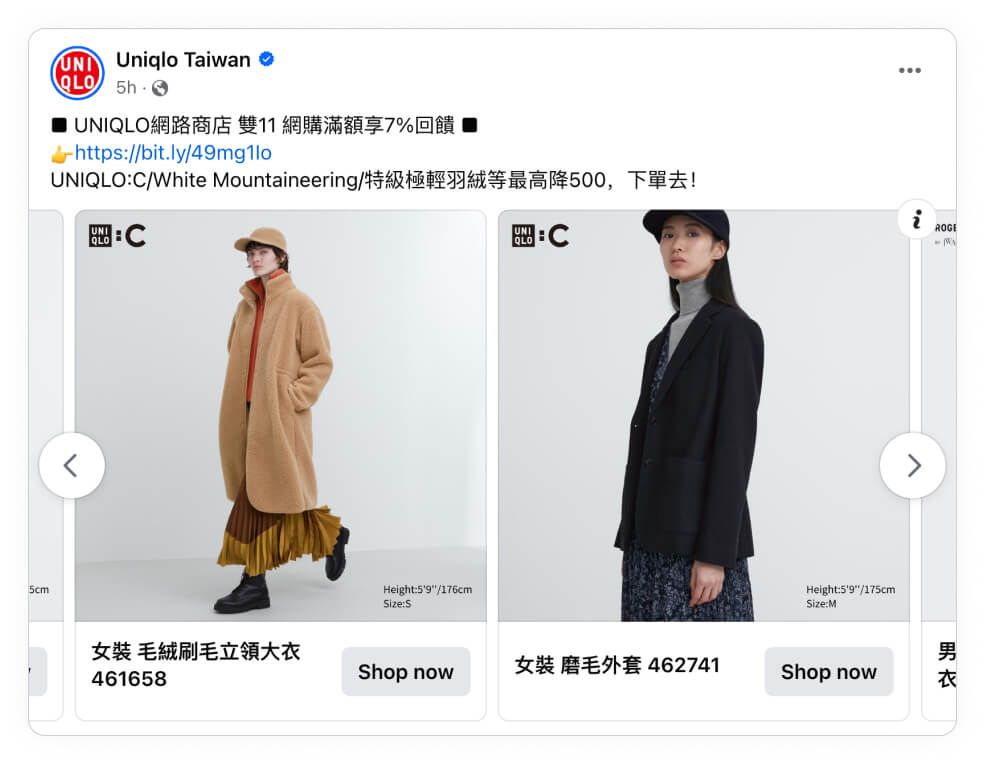
The Catalog Ad above from Uniqlo effectively uses custom labels to highlight model height and size.
Here's how showing custom labels on average influence Catalog Ads:
Return On Ad Spend
+1%
Cost Per Purchase
+31%
Click Through Rate
-1%
Cost Per Click
-5%
Conversion Rate
-41%
Usage
4%
These numbers show how Catalog Ads showing custom labels perform on average compared to Catalog Ads not showing custom labels.
For discount retailers, custom labels have minimal impact on ROAS with just a +1% improvement. This suggests that while such labels may be useful for organization, they're less effective at driving purchasing decisions than direct price and savings information for value-focused shoppers.
Remember that these are average numbers. For some brands, custom labels perform better, and for other brands, custom labels perform worse.
Advantages of showing custom_labels:
Highlights specific qualities that budget shoppers value
Can differentiate between good, better, best options at different price points
Helps categorize products by value proposition
Disadvantages of showing custom_labels:
Less impactful than direct price and savings information
May add complexity to an ad that should focus on simplicity and value
Could be confusing if labels aren't immediately understood
Showing Categories in your Catalog Ads
8% of all discount retailers designing their Catalog Ads with Confect show the category of the product.
For discount retailers with diverse product ranges, category information helps shoppers quickly identify which department an affordable item belongs to.
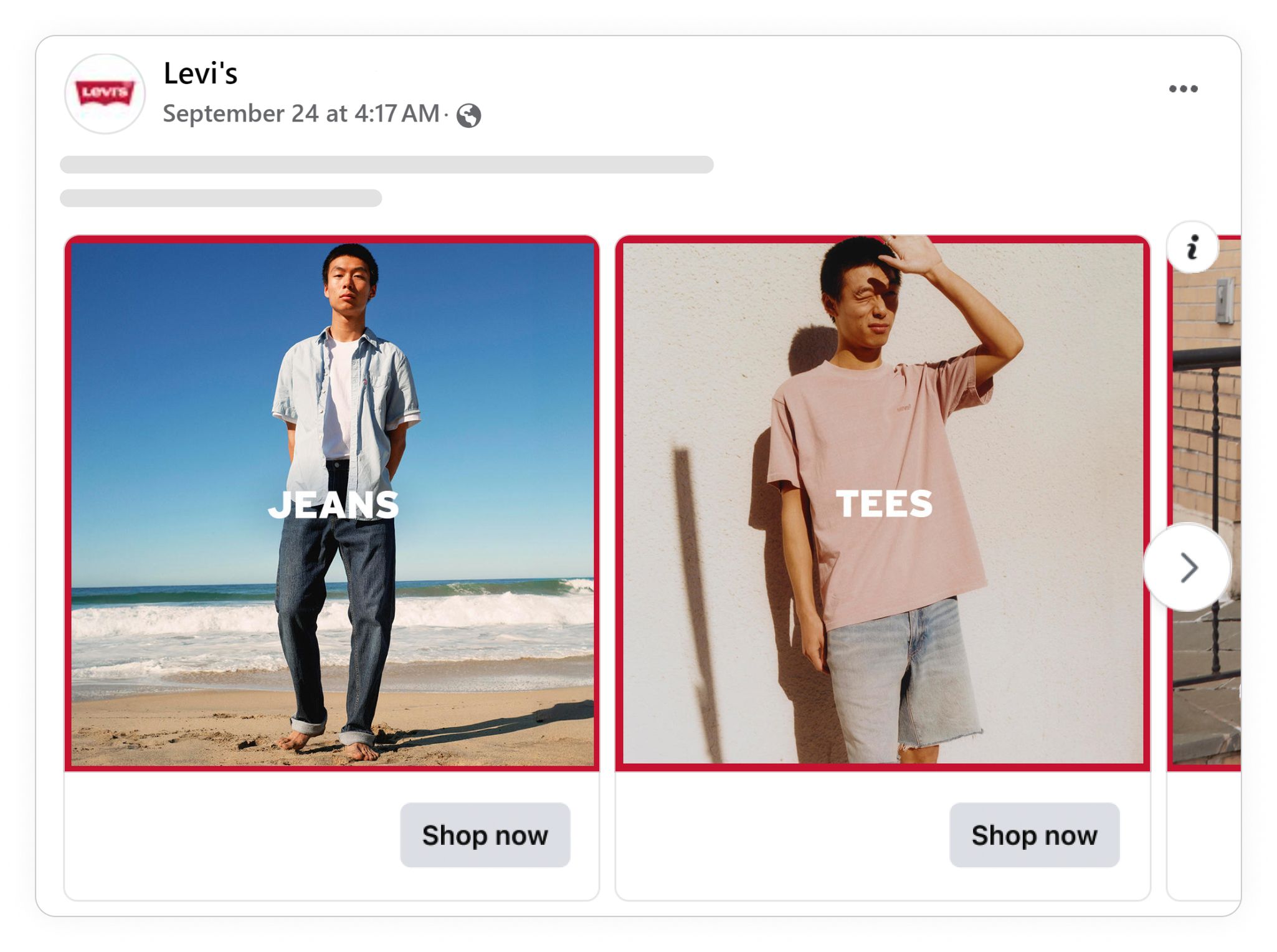
Here's how showing product categories on average influence Catalog Ads:
Return On Ad Spend
+8%
Cost Per Purchase
-51%
Click Through Rate
+19%
Cost Per Click
-20%
Conversion Rate
-5%
Usage
8%
These numbers show how Catalog Ads showing categories perform on average compared to Catalog Ads not showing categories.
For discount retailers, category information delivers a modest +8% ROAS improvement but a more substantial +19% boost in Click Through Rate. This suggests that helping value shoppers quickly identify relevant product types increases initial engagement, even if it doesn't dramatically affect final purchase decisions.
Remember that these are average numbers. For some brands, categories perform better, and for other brands, categories perform worse.
Advantages of showing product category:
Helps budget shoppers quickly identify relevant deal categories
Adds context to generic or unfamiliar discount products
Creates a more organized shopping experience across diverse value offerings
Disadvantages of showing product category:
Less impactful than direct price and savings messaging
May state the obvious for clearly recognizable products
Takes up space that could highlight value-oriented benefits
Showing Product Descriptions in Catalog Ads
2% of all discount retailers designing their Catalog Ads with Confect show parts of the description of the product.
For value retailers, brief descriptions can highlight specific features that justify the product's value despite its affordable price point.
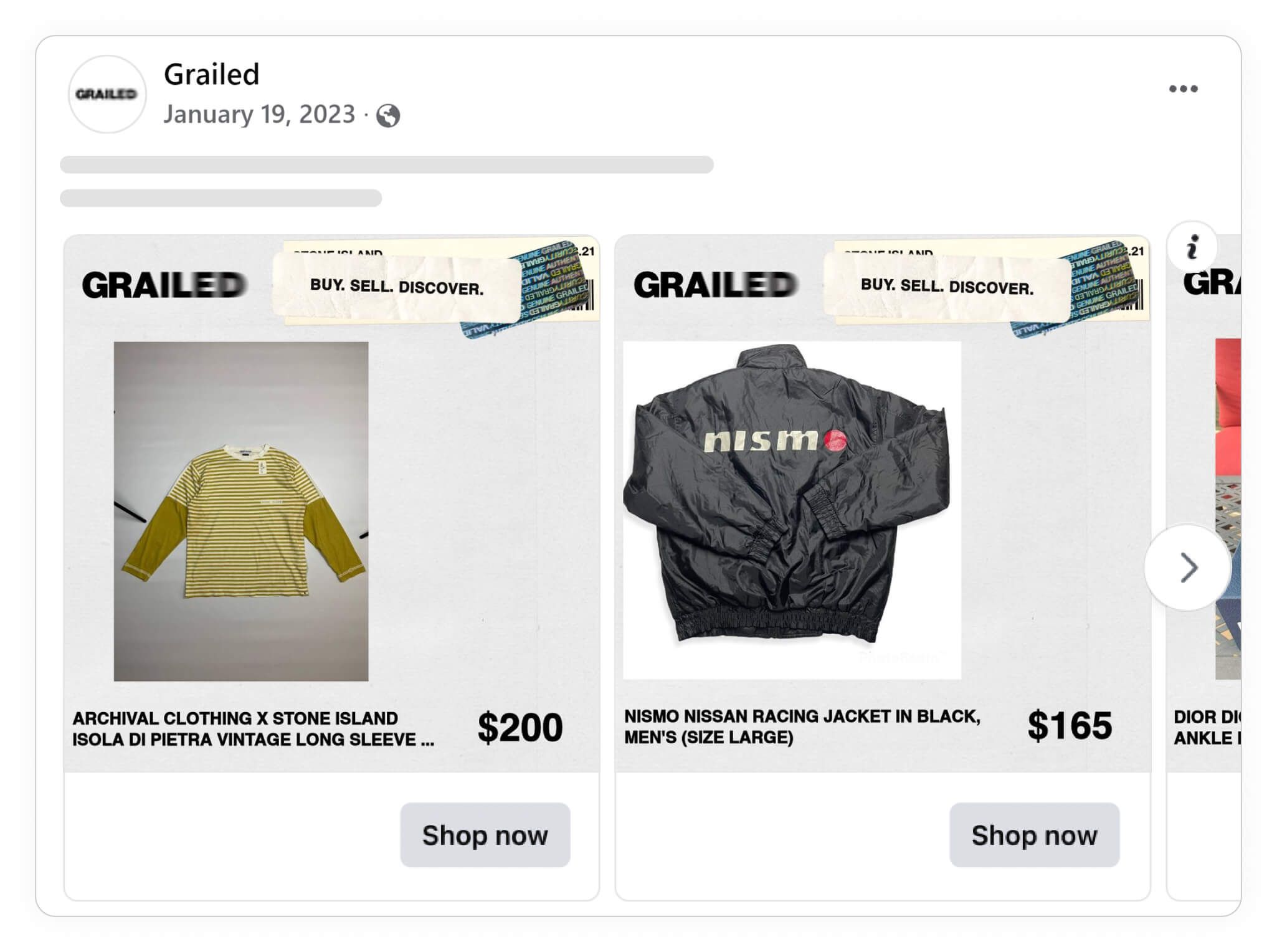
Here's how showing descriptions on average influence Catalog Ads:
Return On Ad Spend
+44%
Cost Per Purchase
+57%
Click Through Rate
+29%
Cost Per Click
-3%
Conversion Rate
-84%
Usage
2%
These numbers show how Catalog Ads showing descriptions perform on average compared to Catalog Ads not showing descriptions.
For discount retailers, product descriptions deliver a solid +44% ROAS improvement and a +29% boost in Click Through Rate. This performance suggests that brief, quality-focused descriptions can effectively address the "too good to be true" skepticism that sometimes accompanies very low prices.
Remember that these are average numbers. For some brands, descriptions perform better, and for other brands, descriptions perform worse.
nd for other brands, descriptions perform worse.
Advantages of showing product descriptions:
Addresses potential quality concerns with low-priced items
Highlights specific value features that justify the purchase
Differentiates similar-looking budget products from each other
Disadvantages of showing product descriptions:
Takes up space that could be used for price and savings messaging
Could overwhelm with too much information in a small space
Might be unnecessary for straightforward, familiar products
Optimizing Catalog Ads for Discount Brands
For discount brands, the money's in the messaging. Showing savings (+115% ROAS) and original prices (+114% ROAS) blow everything else out of the water. On-sale designs (+97%) and social proof (+72%) also perform exceptionally well.
Why? Budget shoppers care about two things: getting a great deal and making sure the product isn't junk despite the low price. Hit both those points and you'll see conversions jump.
Skip the shipping information (-28% ROAS) and custom labels (+1% ROAS) – they just distract from your main selling point: great value.
Keep it simple. Show the price, show the savings, add a touch of quality reassurance, and watch your catalog ads convert price-conscious shoppers like never before.
Bookmark this page by pressing ctrl + D / cmd + D, or by clicking the star icon in your URL bar ⭐️.
